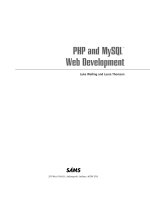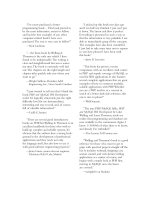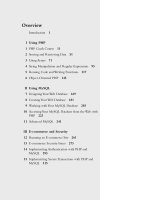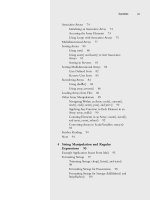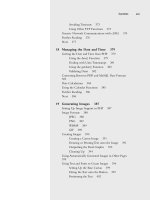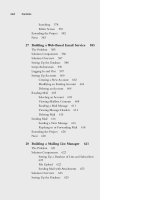PHP and MySQL Web Development
Bạn đang xem bản rút gọn của tài liệu. Xem và tải ngay bản đầy đủ của tài liệu tại đây (7.06 MB, 893 trang )
Luke Welling and Laura Thomson
201 West 103rd St., Indianapolis, Indiana, 46290 USA
PHP and MySQL
Web Development
PHP and MySQL Web Development
Copyright © 2001 by Sams Publishing
All rights reserved. No part of this book shall be reproduced, stored in a
retrieval system, or transmitted by any means, electronic, mechanical, photo-
copying, recording, or otherwise, without written permission from the pub-
lisher. No patent liability is assumed with respect to the use of the information
contained herein. Although every precaution has been taken in the preparation
of this book, the publisher and author assume no responsibility for errors or
omissions. Neither is any liability assumed for damages resulting from the use
of the information contained herein.
International Standard Book Number: 0-672-31784-2
Library of Congress Catalog Card Number: 99-64841
Printed in the United States of America
First Printing: March 2001
04 03 02 01 4 3 2 1
Trademarks
All terms mentioned in this book that are known to be trademarks or service
marks have been appropriately capitalized. Sams Publishing cannot attest to
the accuracy of this information. Use of a term in this book should not be
regarded as affecting the validity of any trademark or service mark.
Warning and Disclaimer
Every effort has been made to make this book as complete and as accurate as
possible, but no warranty or fitness is implied. The information provided is on
an “as is” basis. The authors and the publisher shall have neither liability nor
responsibility to any person or entity with respect to any loss or damages aris-
ing from the information contained in this book or from the use of the CD-
ROM or programs accompanying it.
ACQUISITIONS EDITOR
Shelley Johnston Markanday
DEVELOPMENT EDITOR
Scott D. Meyers
MANAGING EDITOR
Charlotte Clapp
COPY EDITOR
Rhonda Tinch-Mize
INDEXER
Kelly Castell
PROOFREADERS
Kathy Bidwell
Tony Reitz
TECHNICAL EDITORS
Israel Denis
Chris Newman
TEAM COORDINATOR
Amy Patton
SOFTWARE DEVELOPMENT
SPECIALIST
Dan Scherf
INTERIOR DESIGN
Anne Jones
COVER DESIGN
Anne Jones
PRODUCTION
Ayanna Lacey
Heather Hiatt Miller
Stacey Richwine-DeRome
Overview
Introduction 1
PART I Using PHP
1 PHP Crash Course 9
2 Storing and Retrieving Data 49
3 Using Arrays 69
4 String Manipulation and Regular Expressions 93
5 Reusing Code and Writing Functions 117
6 Object-Oriented PHP 147
P
ART II Using MySQL
7 Designing Your Web Database 171
8 Creating Your Web Database 183
9 Working with Your MySQL Database 207
10 Accessing Your MySQL Database from the Web with PHP 227
11 Advanced MySQL 245
P
ART III E-commerce and Security
12 Running an E-commerce Site 267
13 E-commerce Security Issues 281
14 Implementing Authentication with PHP and MySQL 303
15 Implementing Secure Transactions with PHP and MySQL 327
P
ART IV Advanced PHP Techniques
16 Interacting with the File System and the Server 351
17 Using Network and Protocol Functions 369
18 Managing the Date and Time 391
19 Generating Images 401
20 Using Session Control in PHP 429
21 Other Useful Features 447
PART V Building Practical PHP and MySQL Projects
22 Using PHP and MySQL for Large Projects 459
23 Debugging 477
24 Building User Authentication and Personalization 497
25 Building a Shopping Cart 539
26 Building a Content Management System 587
27 Building a Web-Based Email Service 617
28 Building a Mailing List Manager 655
29 Building Web Forums 711
30 Generating Personalized Documents in Portable Document Format (PDF) 743
P
ART VI
A Installing PHP 4 and MySQL 781
B Web Resources 803
Index 807
Contents
Introduction 1
Who Should Read This Book? 1
What Is PHP? 1
What Is MySQL? 2
Why Use PHP and MySQL? 2
Some of PHP’s Strengths 3
Performance 3
Database Integration 3
Built-In Libraries 4
Cost 4
Learning PHP 4
Portability 4
Source Code 4
Some of MySQL’s Strengths 4
Performance 5
Low Cost 5
Ease of Use 5
Portability 5
Source Code 5
How Is This Book Organized? 5
What’s New in PHP Version 4? 6
Finally 6
PART I Using PHP 7
1 PHP Crash Course 9
Using PHP 11
Sample Application: Bob’s Auto Parts 11
The Order Form 11
Processing the Form 13
Embedding PHP in HTML 13
Using PHP Tags 14
PHP Tag Styles 15
PHP Statements 15
Whitespace 16
Comments 16
Adding Dynamic Content 17
Calling Functions 18
The date() Function 18
PHP AND MYSQL WEB DEVELOPMENT
vi
Accessing Form Variables 19
Form Variables 19
String Concatenation 20
Variables and Literals 21
Identifiers 21
User-Declared Variables 22
Assigning Values to Variables 22
Variable Types 22
PHP’s Data Types 22
Type Strength 23
Type Casting 23
Variable Variables 23
Constants 24
Variable Scope 25
Operators 25
Arithmetic Operators 26
String Operators 27
Assignment Operators 27
Comparison Operators 29
Logical Operators 30
Bitwise Operators 31
Other Operators 32
Using Operators: Working Out the Form Totals 33
Precedence and Associativity: Evaluating Expressions 34
Variable Functions 36
Testing and Setting Variable Types 36
Testing Variable Status 37
Reinterpreting Variables 37
Control Structures 38
Making Decisions with Conditionals 38
if Statements 38
Code Blocks 38
A Side Note: Indenting Your Code 39
else Statements 39
elseif Statements 40
switch Statements 41
Comparing the Different Conditionals 42
Iteration: Repeating Actions 43
while Loops 44
for Loops 45
do while Loops 46
CONTENTS
vii
Breaking Out of a Control Structure or Script 47
Next: Saving the Customer’s Order 47
2 Storing and Retrieving Data 49
Saving Data for Later 50
Storing and Retrieving Bob’s Orders 50
Overview of File Processing 52
Opening a File 52
File Modes 52
Using fopen() to Open a File 53
Opening Files for FTP or HTTP 54
Problems Opening Files 55
Writing to a File 57
Parameters for fwrite() 57
File Formats 58
Closing a File 58
Reading from a File 59
Opening a File for Reading: fopen() 60
Knowing When to Stop: feof() 60
Reading a Line at a Time: fgets(), fgetss(), and fgetcsv() 60
Reading the Whole File: readfile(), fpassthru(), file() 61
Reading a Character: fgetc() 62
Reading an Arbitrary Length: fread() 63
Other Useful File Functions 63
Checking Whether a File Is There: file_exists() 63
Knowing How Big a File Is: filesize() 63
Deleting a File: unlink() 63
Navigating Inside a File: rewind(), fseek(), and ftell() 64
File Locking 65
Doing It a Better Way: Database Management Systems 66
Problems with Using Flat Files 66
How RDBMSs Solve These Problems 67
Further Reading 67
Next 67
3 Using Arrays 69
What Is an Array? 70
Numerically Indexed Arrays 71
Initializing Numerically Indexed Arrays 71
Accessing Array Contents 72
Using Loops to Access the Array 73
PHP AND MYSQL WEB DEVELOPMENT
viii
Associative Arrays 73
Initializing an Associative Array 73
Accessing the Array Elements 73
Using Loops with each() and list() 74
Multidimensional Arrays 75
Sorting Arrays 79
Using sort() 79
Using asort() and ksort() to Sort Associative Arrays 79
Sorting in Reverse 80
Sorting Multidimensional Arrays 80
User Defined Sorts 80
Reverse User Sorts 82
Reordering Arrays 83
Using shuffle() 83
Using array_reverse() 84
Loading Arrays from Files 85
Other Array Manipulations 88
Navigating Within an Array: each, current(), reset(),
end(), next(), pos(), and prev() 88
Applying Any Function to Each Element in an Array:
array_walk() 89
Counting Elements in an Array: count(), sizeof(), and
array_count_values() 90
Converting Arrays to Scalar Variables: extract() 91
Further Reading 92
Next 92
4 String Manipulation and Regular Expressions 93
Example Application: Smart Form Mail 94
Formatting Strings 96
Trimming Strings: chop(), ltrim(), and trim() 96
Formatting Strings for Presentation 97
Formatting Strings for Storage: AddSlashes() and StripSlashes() 100
Joining and Splitting Strings with String Functions 101
Using explode(), implode(), and join() 102
Using strtok() 102
Using substr() 103
Comparing Strings 104
String Ordering: strcmp(),strcasecmp(), and strnatcmp() 104
Testing String Length with strlen() 105
Matching and Replacing Substrings with String Functions 105
Finding Strings in Strings: strstr(), strchr(), strrchr(), stristr() 106
Finding the Position of a Substring: strpos(), strrpos() 107
Replacing Substrings: str_replace(), substr_replace() 108
CONTENTS
ix
Introduction to Regular Expressions 109
The Basics 109
Character Sets and Classes 110
Repetition 111
Subexpressions 111
Counted Subexpressions 112
Anchoring to the Beginning or End of a String 112
Branching 112
Matching Literal Special Characters 112
Summary of Special Characters 113
Putting It All Together for the Smart Form 113
Finding Substrings with Regular Expressions 114
Replacing Substrings with Regular Expressions 115
Splitting Strings with Regular Expressions 115
Comparison of String Functions and Regular Expression
Functions 116
Further Reading 116
Next 116
5 Reusing Code and Writing Functions 117
Why Reuse Code? 118
Cost 118
Reliability 119
Consistency 119
Using require() and include() 119
Using require() 119
File Name Extensions and Require() 120
PHP Tags and require() 121
Using require() for Web Site Templates 121
Using auto_prepend_file and auto_append_file 126
Using include() 127
Using Functions in PHP 129
Calling Functions 129
Call to Undefined Function 131
Case and Function Names 132
Why Should You Define Your Own Functions? 132
Basic Function Structure 132
Naming Your Function 133
Parameters 134
Scope 136
Pass by Reference Versus Pass by Value 138
Returning from Functions 140
PHP AND MYSQL WEB DEVELOPMENT
x
Returning Values from Functions 141
Code Blocks 142
Recursion 143
Further Reading 145
Next 145
6 Object-Oriented PHP 147
Object-Oriented Concepts 148
Classes and Objects 148
Polymorphism 149
Inheritance 150
Creating Classes, Attributes, Operations in PHP 150
Structure of a Class 151
Constructors 151
Instantiation 152
Using Class Attributes 152
Calling Class Operations 154
Implementing Inheritance in PHP 155
Overriding 156
Multiple Inheritance 157
Designing Classes 158
Writing the Code for Your Class 159
Next 168
PART II Using MySQL 169
7 Designing Your Web Database 171
Relational Database Concepts 172
Tables 173
Columns 173
Rows 173
Values 173
Keys 173
Schemas 175
Relationships 175
How to Design Your Web Database 176
Think About the Real World Objects You Are Modeling 176
Avoid Storing Redundant Data 176
Use Atomic Column Values 178
Choose Sensible Keys 179
Think About the Questions You Want to Ask the Database 179
Avoid Designs with Many Empty Attributes 179
Summary of Table Types 180
CONTENTS
xi
Web Database Architecture 180
Architecture 180
Further Reading 182
Next 182
8 Creating Your Web Database 183
A Note on Using the MySQL Monitor 185
How to Log In to MySQL 185
Creating Databases and Users 187
Creating the Database 187
Users and Privileges 187
Introduction to MySQL’s Privilege System 188
Principle of Least Privilege 188
Setting Up Users: The GRANT Command 188
Types and Levels of Privilege 190
The REVOKE Command 192
Examples Using GRANT and REVOKE 192
Setting Up a User for the Web 193
Logging Out As root 193
Using the Right Database 193
Creating Database Tables 194
What the Other Keywords Mean 196
Understanding the Column Types 196
Looking at the Database with SHOW and DESCRIBE 198
MySQL Identifiers 199
Column Data Types 200
Numeric Types 201
Further Reading 206
Next 206
9 Working with Your MySQL Database 207
What Is SQL? 208
Inserting Data into the Database 209
Retrieving Data from the Database 211
Retrieving Data with Specific Criteria 212
Retrieving Data from Multiple Tables 214
Retrieving Data in a Particular Order 219
Grouping and Aggregating Data 220
Choosing Which Rows to Return 222
Updating Records in the Database 223
Altering Tables After Creation 223
Deleting Records from the Database 225
Dropping Tables 226
PHP AND MYSQL WEB DEVELOPMENT
Dropping a Whole Database 226
Further Reading 226
Next 226
10 Accessing Your MySQL Database from the Web
with PHP 227
How Web Database Architectures Work 228
The Basic Steps in Querying a Database
from the Web 232
Checking and Filtering Input Data 232
Setting Up a Connection 234
Choosing a Database to Use 235
Querying the Database 235
Retrieving the Query Results 236
Disconnecting from the Database 238
Putting New Information in the Database 238
Other Useful PHP-MySQL Functions 241
Freeing Up Resources 241
Creating and Deleting Databases 242
Other PHP-Database Interfaces 242
Further Reading 242
Next 243
11 Advanced MySQL 245
Understanding the Privilege System in Detail 246
The user Table 247
The db and host Tables 248
The tables_priv and columns_priv Tables 249
Access Control: How MySQL Uses the Grant Tables 250
Updating Privileges: When Do Changes Take Effect? 251
Making Your MySQL Database Secure 251
MySQL from the Operating System’s Point of View 252
Passwords 252
User Privileges 253
Web Issues 253
Getting More Information About Databases 254
Getting Information with SHOW 254
Getting Information About Columns with DESCRIBE 257
Understanding How Queries Work with EXPLAIN 257
Speeding Up Queries with Indexes 261
General Optimization Tips 261
Design Optimization 261
Permissions 261
xii
CONTENTS
Table Optimization 262
Using Indexes 262
Use Default Values 262
Use Persistent Connections 262
Other Tips 262
Different Table Types 263
Loading Data from a File 263
Further Reading 264
Next 264
PART III E-commerce and Security 265
12 Running an E-commerce Site 267
What Do You Want to Achieve? 268
Types of Commercial Web Sites 268
Online Brochures 269
Taking Orders for Goods or Services 271
Providing Services and Digital Goods 275
Adding Value to Goods or Services 276
Cutting Costs 276
Risks and Threats 277
Crackers 277
Failing to Attract Sufficient Business 278
Computer Hardware Failure 278
Power, Communication, Network, or Shipping Failures 278
Extensive Competition 278
Software Errors 279
Evolving Governmental Policies and Taxes 279
System Capacity Limits 279
Deciding on a Strategy 280
Next 280
13 E-commerce Security Issues 281
How Important Is Your Information? 282
Security Threats 283
Exposure of Confidential Data 283
Loss or Destruction of Data 285
Modification of Data 286
Denial of Service 287
Errors in Software 288
Repudiation 289
Balancing Usability, Performance, Cost, and Security 290
Creating a Security Policy 291
xiii
PHP AND MYSQL WEB DEVELOPMENT
Authentication Principles 291
Using Authentication 292
Encryption Basics 293
Private Key Encryption 294
Public Key Encryption 295
Digital Signatures 296
Digital Certificates 297
Secure Web Servers 298
Auditing and Logging 299
Firewalls 300
Backing Up Data 301
Backing Up General Files 301
Backing Up and Restoring Your MySQL Database 301
Physical Security 302
Next 302
14 Implementing Authentication with PHP and MySQL 303
Identifying Visitors 304
Implementing Access Control 305
Storing Passwords 308
Encrypting Passwords 310
Protecting Multiple Pages 312
Basic Authentication 312
Using Basic Authentication in PHP 314
Using Basic Authentication with Apache’s .htaccess Files 316
Using Basic Authentication with IIS 319
Using mod_auth_mysql Authentication 321
Installing mod_auth_mysql 322
Did It Work? 323
Using mod_auth_mysql 323
Creating Your Own Custom Authentication 324
Further Reading 324
Next 325
15 Implementing Secure Transactions with PHP and MySQL 327
Providing Secure Transactions 328
The User’s Machine 329
The Internet 330
Your System 331
Using Secure Sockets Layer (SSL) 332
Screening User Input 336
Providing Secure Storage 336
Why Are You Storing Credit Card Numbers? 338
xiv
CONTENTS
Using Encryption in PHP 338
Further Reading 347
Next 347
PART IV Advanced PHP Techniques 349
16 Interacting with the File System and the Server 351
Introduction to File Upload 352
HTML for File Upload 353
Writing the PHP to Deal with the File 354
Common Problems 358
Using Directory Functions 358
Reading from Directories 358
Getting Info About the Current Directory 360
Creating and Deleting Directories 360
Interacting with the File System 361
Get File Info 361
Changing File Properties 364
Creating, Deleting, and Moving Files 364
Using Program Execution Functions 365
Interacting with the Environment: getenv() and putenv() 367
Further Reading 368
Next 368
17 Using Network and Protocol Functions 369
Overview of Protocols 370
Sending and Reading Email 371
Using Other Web Services 371
Using Network Lookup Functions 374
Using FTP 378
Using FTP to Back Up or Mirror a File 378
Uploading Files 385
Avoiding Timeouts 385
Using Other FTP Functions 386
Generic Network Communications with cURL 387
Further Reading 389
Next 390
18 Managing the Date and Time 391
Getting the Date and Time from PHP 392
Using the date() Function 392
Dealing with UNIX Time Stamps 394
Using the getdate() Function 395
Validating Dates 396
xv
PHP AND MYSQL WEB DEVELOPMENT
Converting Between PHP and MySQL Date Formats 396
Date Calculations 398
Using the Calendar Functions 399
Further Reading 400
Next 400
19 Generating Images 401
Setting Up Image Support in PHP 402
Image Formats 403
JPEG 403
PNG 403
WBMP 403
GIF 404
Creating Images 404
Creating a Canvas Image 405
Drawing or Printing Text onto the Image 406
Outputting the Final Graphic 408
Cleaning Up 410
Using Automatically Generated Images in Other Pages 410
Using Text and Fonts to Create Images 410
Setting Up the Base Canvas 414
Fitting the Text onto the Button 415
Positioning the Text 418
Writing the Text onto the Button 419
Finishing Up 419
Drawing Figures and Graphing Data 419
Other Image Functions 428
Further Reading 428
Next 428
20 Using Session Control in PHP 429
What Session Control Is 430
Basic Session Functionality 430
What Is a Cookie? 431
Setting Cookies from PHP 431
Using Cookies with Sessions 432
Storing the Session ID 432
Implementing Simple Sessions 433
Starting a Session 433
Registering Session Variables 433
Using Session Variables 434
Deregistering Variables and Destroying the Session 434
xvi
CONTENTS
Simple Session Example 435
Configuring Session Control 437
Implementing Authentication with Session Control 438
Further Reading 445
Next 445
21 Other Useful Features 447
Using Magic Quotes 448
Evaluating Strings: eval() 449
Terminating Execution: die and exit 450
Serialization 450
Getting Information About the PHP Environment 451
Finding Out What Extensions Are Loaded 451
Identifying the Script Owner 452
Finding Out When the Script Was Modified 452
Loading Extensions Dynamically 453
Temporarily Altering the Runtime Environment 453
Source Highlighting 454
Next 455
PART V Building Practical PHP and MySQL Projects 457
22 Using PHP and MySQL for Large Projects 459
Applying Software Engineering to Web Development 460
Planning and Running a Web Application Project 461
Reusing Code 462
Writing Maintainable Code 463
Coding Standards 463
Breaking Up Code 466
Using a Standard Directory Structure 467
Documenting and Sharing In-House Functions 467
Implementing Version Control 467
Choosing a Development Environment 469
Documenting Your Projects 470
Prototyping 471
Separating Logic and Content 471
Optimizing Code 472
Using Simple Optimizations 472
Using Zend Products 473
Testing 474
Further Reading 475
Next 475
xvii
PHP AND MYSQL WEB DEVELOPMENT
23 Debugging 477
Programming Errors 478
Syntax Errors 478
Runtime Errors 480
Logic Errors 485
Variable Debugging Aid 486
Error Reporting Levels 489
Altering the Error Reporting Settings 490
Triggering Your Own Errors 492
Handling Errors Gracefully 492
Remote Debugging 494
Next 495
24 Building User Authentication and Personalization 497
The Problem 498
Solution Components 499
User Identification and Personalization 499
Storing Bookmarks 500
Recommending Bookmarks 500
Solution Overview 500
Implementing the Database 502
Implementing the Basic Site 504
Implementing User Authentication 506
Registering 507
Logging In 513
Logging Out 517
Changing Passwords 518
Resetting Forgotten Passwords 521
Implementing Bookmark Storage and Retrieval 526
Adding Bookmarks 526
Displaying Bookmarks 529
Deleting Bookmarks 530
Implementing Recommendations 532
Wrapping Up and Possible Extensions 537
Next 537
25 Building a Shopping Cart 539
The Problem 540
Solution Components 540
Building an Online Catalog 540
Tracking a User’s Purchases While She Shops 541
Payment 541
Administration Interface 542
xviii
CONTENTS
Solution Overview 542
Implementing the Database 546
Implementing the Online Catalog 548
Listing Categories 551
Listing Books in a Category 553
Showing Book Details 555
Implementing the Shopping Cart 556
Using the show_cart.php Script 557
Viewing the Cart 560
Adding Items to the Cart 563
Saving the Updated Cart 565
Printing a Header Bar Summary 566
Checking Out 566
Implementing Payment 572
Implementing an Administration Interface 575
Extending the Project 584
Using an Existing System 584
Next 585
26 Building a Content Management System 587
The Problem 588
Solution Requirements 588
Editing Content 589
Getting Content into the System 589
Databases Versus File Storage 591
Document Structure 592
Using Metadata 592
Formatting the Output 593
Image Manipulation 594
Solution Design/Overview 596
Designing the Database 598
Implementation 599
Front End 599
Back End 603
Searching 611
Editor Screen 614
Extending the Project 615
27 Building a Web-Based Email Service 617
The Problem 618
Solution Components 619
Solution Overview 620
Setting Up the Database 622
xix
PHP AND MYSQL WEB DEVELOPMENT
Script Architecture 623
Logging In and Out 629
Setting Up Accounts 632
Creating a New Account 634
Modifying an Existing Account 636
Deleting an Account 636
Reading Mail 637
Selecting an Account 637
Viewing Mailbox Contents 640
Reading a Mail Message 643
Viewing Message Headers 647
Deleting Mail 648
Sending Mail 649
Sending a New Message 649
Replying To or Forwarding Mail 651
Extending the Project 652
Next 653
28 Building a Mailing List Manager 655
The Problem 656
Solution Components 657
Setting Up a Database of Lists and Subscribers 657
File Upload 657
Sending Mail with Attachments 658
Solution Overview 658
Setting Up the Database 660
Script Architecture 663
Implementing Login 672
Creating a New Account 673
Logging In 675
Implementing User Functions 678
Viewing Lists 679
Viewing List Information 684
Viewing List Archives 686
Subscribing and Unsubscribing 687
Changing Account Settings 689
Changing Passwords 689
Logging Out 692
Implementing Administrative Functions 693
Creating a New List 693
Uploading a New Newsletter 695
Handling Multiple File Upload 698
xx
CONTENTS
Previewing the Newsletter 703
Sending the Message 704
Extending the Project 709
Next 709
29 Building Web Forums 711
The Problem 712
Solution Components 712
Solution Overview 714
Designing the Database 716
Viewing the Tree of Articles 718
Expanding and Collapsing 721
Displaying the Articles 724
Using the treenode Class 725
Viewing Individual Articles 731
Adding New Articles 734
Extensions 741
Using an Existing System 741
Next 742
30 Generating Personalized Documents in Portable
Format (PDF) 743
The Problem 744
Evaluating Document Formats 745
Paper 745
ASCII 745
HTML 745
Word Processor Formats 746
Rich Text Format 746
PostScript 747
Portable Document Format 748
Solution Components 749
Question and Answer System 749
Document Generation Software 749
Solution Overview 752
Asking the Questions 753
Grading the Answers 755
Generating an RTF Certificate 758
Generating a PDF Certificate from a Template 762
Generating a PDF Document Using PDFlib 765
A Hello World Script for PDFlib 766
Generating Our Certificate with PDFlib 770
xxi
PHP AND MYSQL WEB DEVELOPMENT
Problems with Headers 777
Extending the Project 778
Further Reading 778
PART VI Appendixes 779
A Installing PHP 4 and MySQL 781
Running PHP as a CGI Interpreter or Module 782
Installing Apache, PHP, and MySQL Under UNIX 783
Apache and mod_SSL 787
httpd.conf File—Snippets 790
Is SSL Working? 792
Installing Apache, PHP, and MySQL Under Windows 793
Installing MySQL Under Windows 793
Installing Apache Under Windows 795
Differences Between Apache for Windows and UNIX 798
Installing PHP for Windows 799
Installation Notes for Microsoft IIS 800
Installation Notes for Microsoft PWS 802
Other Configurations 802
B Web Resources 803
PHP Resources 804
MySQL and SQL Specific Resources 806
Apache Resources 806
Web Development 806
Index 807
xxii
About the Authors
Laura Thomson is a lecturer in Web programming in the Department of Computer Science at
RMIT University in Melbourne, Australia. She is also a partner in the award-winning Web
development firm Tangled Web Design. Laura has previously worked for Telstra and the
Boston Consulting Group. She holds a Bachelor of Applied Science (Computer Science)
degree and a Bachelor of Engineering (Computer Systems Engineering) degree with honors,
and is currently completing her Ph.D. in adaptive Web sites. In her spare time, she enjoys
sleeping. Laura can be contacted at
Luke Welling is a lecturer in software engineering and e-commerce in the School of Electrical
and Computer Systems Engineering at RMIT University in Melbourne, Australia. He is also a
partner in Tangled Web Design. He holds a Bachelor of Applied Science (Computer Science)
degree and is currently completing a master’s degree in Genetic Algorithms for Communication
Network Design. In his spare time, he attempts to perfect his insomnia. Luke can be contacted
at
About the Contributors
Israel Denis Jr. is a freelance consultant working on e-commerce projects throughout the
world. He specializes in integrating ERP packages such as SAP and Lawson with custom Web
solutions. He obtained a master’s degree in Electrical Engineering from Georgia Tech in
Atlanta, Georgia in 1998. He is the author of numerous articles about Linux, Apache, PHP, and
MySQL and can be reached via email at
Chris Newman is a consultant programmer specializing in the development of dynamic
Internet applications. He has extensive commercial experience in using PHP and MySQL to
produce a wide range of applications for an international client base. A graduate of Keele
University, he lives in Stoke-on-Trent, England, where he runs Lightwood Consultancy Ltd.
More information on Lightwood Consultancy Ltd can be found at
, and Newman can be contacted at
Dedication
To our Mums and Dads.
Acknowledgments
We would like to thank the team at Sams for all their hard work. In particular, we would like to
thank Shelley Johnston Markanday without whose dedication and patience this book would not
have been possible. We would also like to thank Israel Denis Jr. and Chris Newman for their
valuable contributions.
We appreciate immensely the work done by the PHP and MySQL development teams. Their
work has made our lives easier for a number of years now, and continues to do so on a daily
basis.
We thank Adrian Close at eSec for saying “You can build that in PHP” back in 1998. We also
thank James Woods and all the staff at Law Partners for giving us such interesting work to test
the boundaries of PHP with.
Finally, we would like to thank our family and friends for putting up with us while we have
been antisocial for the better part of a year. Specifically, thank you for your support to our
family members: Julie, Robert, Martin, Lesley, Adam, Paul, Sandi, James, and Archer.
Tell Us What You Think!
As the reader of this book, you are our most important critic and commentator. We value your
opinion and want to know what we’re doing right, what we could do better, what areas you’d
like to see us publish in, and any other words of wisdom you’re willing to pass our way.
You can email or write me directly to let me know what you did or didn’t like about this
book—as well as what we can do to make our books stronger.
Please note that I cannot help you with technical problems related to the topic of this book,
and that due to the high volume of mail I receive, I might not be able to reply to every
message.
When you write, please be sure to include this book’s title and author as well as your name
and phone or email address. I will carefully review your comments and share them with the
author and editors who worked on the book.
E-mail:
Mail: Mark Taber
Associate Publisher
Sams Publishing
201 West 103rd Street
Indianapolis, IN 46290 USA

